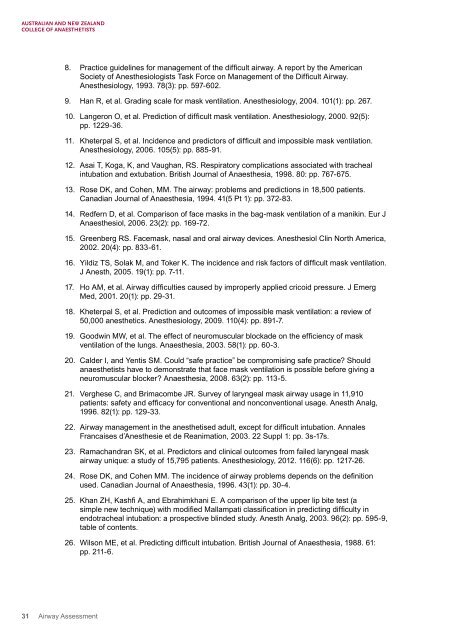Airway Assessment
2cKbSEQ
2cKbSEQ
You also want an ePaper? Increase the reach of your titles
YUMPU automatically turns print PDFs into web optimized ePapers that Google loves.
8. Practice guidelines for management of the difficult airway. A report by the American<br />
Society of Anesthesiologists Task Force on Management of the Difficult <strong>Airway</strong>.<br />
Anesthesiology, 1993. 78(3): pp. 597-602.<br />
9. Han R, et al. Grading scale for mask ventilation. Anesthesiology, 2004. 101(1): pp. 267.<br />
10. Langeron O, et al. Prediction of difficult mask ventilation. Anesthesiology, 2000. 92(5):<br />
pp. 1229-36.<br />
11. Kheterpal S, et al. Incidence and predictors of difficult and impossible mask ventilation.<br />
Anesthesiology, 2006. 105(5): pp. 885-91.<br />
12. Asai T, Koga, K, and Vaughan, RS. Respiratory complications associated with tracheal<br />
intubation and extubation. British Journal of Anaesthesia, 1998. 80: pp. 767-675.<br />
13. Rose DK, and Cohen, MM. The airway: problems and predictions in 18,500 patients.<br />
Canadian Journal of Anaesthesia, 1994. 41(5 Pt 1): pp. 372-83.<br />
14. Redfern D, et al. Comparison of face masks in the bag-mask ventilation of a manikin. Eur J<br />
Anaesthesiol, 2006. 23(2): pp. 169-72.<br />
15. Greenberg RS. Facemask, nasal and oral airway devices. Anesthesiol Clin North America,<br />
2002. 20(4): pp. 833-61.<br />
16. Yildiz TS, Solak M, and Toker K. The incidence and risk factors of difficult mask ventilation.<br />
J Anesth, 2005. 19(1): pp. 7-11.<br />
17. Ho AM, et al. <strong>Airway</strong> difficulties caused by improperly applied cricoid pressure. J Emerg<br />
Med, 2001. 20(1): pp. 29-31.<br />
18. Kheterpal S, et al. Prediction and outcomes of impossible mask ventilation: a review of<br />
50,000 anesthetics. Anesthesiology, 2009. 110(4): pp. 891-7.<br />
19. Goodwin MW, et al. The effect of neuromuscular blockade on the efficiency of mask<br />
ventilation of the lungs. Anaesthesia, 2003. 58(1): pp. 60-3.<br />
20. Calder I, and Yentis SM. Could “safe practice” be compromising safe practice? Should<br />
anaesthetists have to demonstrate that face mask ventilation is possible before giving a<br />
neuromuscular blocker? Anaesthesia, 2008. 63(2): pp. 113-5.<br />
21. Verghese C, and Brimacombe JR. Survey of laryngeal mask airway usage in 11,910<br />
patients: safety and efficacy for conventional and nonconventional usage. Anesth Analg,<br />
1996. 82(1): pp. 129-33.<br />
22. <strong>Airway</strong> management in the anesthetised adult, except for difficult intubation. Annales<br />
Francaises d’Anesthesie et de Reanimation, 2003. 22 Suppl 1: pp. 3s-17s.<br />
23. Ramachandran SK, et al. Predictors and clinical outcomes from failed laryngeal mask<br />
airway unique: a study of 15,795 patients. Anesthesiology, 2012. 116(6): pp. 1217-26.<br />
24. Rose DK, and Cohen MM. The incidence of airway problems depends on the definition<br />
used. Canadian Journal of Anaesthesia, 1996. 43(1): pp. 30-4.<br />
25. Khan ZH, Kashfi A, and Ebrahimkhani E. A comparison of the upper lip bite test (a<br />
simple new technique) with modified Mallampati classification in predicting difficulty in<br />
endotracheal intubation: a prospective blinded study. Anesth Analg, 2003. 96(2): pp. 595-9,<br />
table of contents.<br />
26. Wilson ME, et al. Predicting difficult intubation. British Journal of Anaesthesia, 1988. 61:<br />
pp. 211-6.<br />
31 <strong>Airway</strong> <strong>Assessment</strong>


